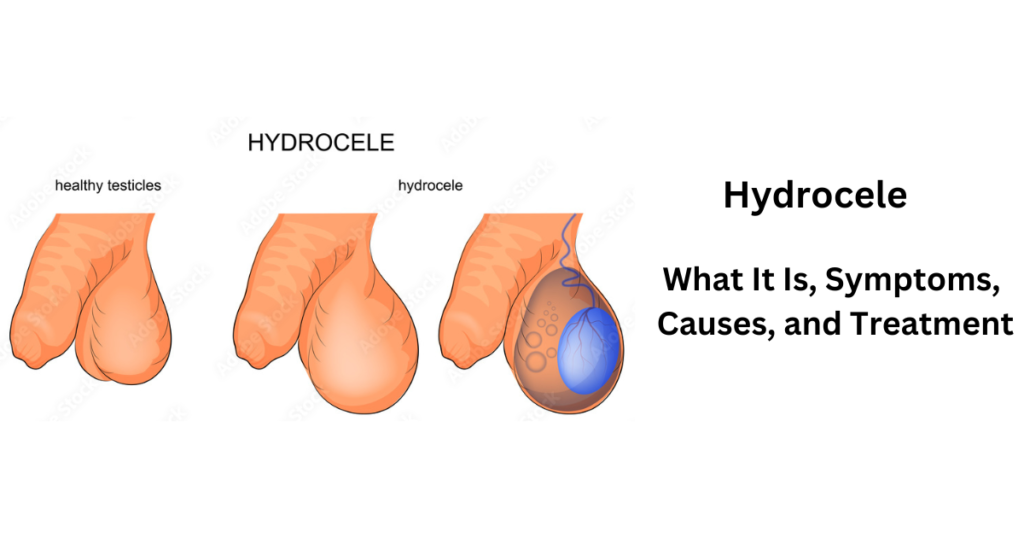Hydrocele: What Its Causes, Symptoms and Treatments – Hydrocele is a common medical condition that affects males of all ages. While it is generally not a serious condition, it can cause discomfort and anxiety. In this comprehensive blog, we will delve into the world of hydrocele, exploring its causes, symptoms, and the various treatment options available to manage this condition.
Table of Contents
What is a Hydrocele?
A hydrocele is a fluid-filled sac that forms in the scrotum, the pouch of skin and muscle that holds the testicles. This condition occurs when fluid accumulates around the testicle, causing the scrotum to swell. Hydroceles are typically painless and benign but can cause discomfort, especially when they become large. Hydroceles can affect one or both testicles.
Types of Hydrocele
A hydrocele is a medical condition characterized by the accumulation of fluid in a sac within the scrotum. There are two main types of hydroceles:
1. Non-communicating Hydrocele:
This form, which is more typical, is sometimes referred to as simple or idiopathic hydrocele. The tunica vaginalis, which surrounds the testicle, is not directly connected to the abdominal cavity in a non-communicating hydrocele. The sac becomes clogged with fluid and is often shut off and closed. This particular sort of hydrocele is frequently brought on by a natural buildup of the fluid that typically surrounds the testicle.
2. Communicating Hydrocele:
An open passageway exists between the tunica vaginalis and the abdominal cavity in a communicative hydrocele. As a result, there may be a slight filling and emptying of the scrotum due to fluid flowing back and forth. A disorder called an inguinal hernia, in which a part of the small intestine or other tissue protrudes into the groin or scrotum, is one that frequently goes hand in hand with communicating hydroceles. Because of this, surgical treatment of the underlying problem may be necessary for this kind of hydrocele.
Common Causes of Hydrocele
A hydrocele is a condition characterized by the accumulation of fluid in a sac within the scrotum. There can be various causes of hydroceles, but the most common ones include:
1. Idiopathic:
The most typical type of hydroceles is idiopathic hydroceles, sometimes referred to as simple or non-communicating hydroceles. These hydroceles frequently have no obvious underlying reason and may be the consequence of regular fluid buildup in the tunica vaginalis, the sac that encloses the testis.
2. Infection:
A hydrocele can form as a result of infections in the scrotum or the surrounding area. For instance, fluid buildup can result from orchitis, an infection of the testis, or epididymitis, an inflammation of the epididymis, a tissue connected to the testis.
3. Injury or trauma:
By injuring blood or lymphatic vessels in the scrotum or the surrounding area, an injury or trauma can result in hydroceles, which causes fluid to build up in the tunica vaginalis. Direct hits, sports-related injuries, or surgical procedures can all cause this. Indirect trauma, such as injuries to the abdomen or pelvis, can potentially alter scrotal fluid dynamics and hasten the development of hydrocele.
4. Inguinal Hernia:
Inguinal hernias and communicating hydroceles frequently occur together. An inguinal hernia happens when a section of the small intestine or other tissue pushes through a weakness or defect in the abdominal wall and into the groin or scrotum. This may open a pathway for fluid to travel between the scrotum and abdominal cavity, leading to a hydrocele.

Symptoms of Hydrocele
Symptoms of a hydrocele can vary depending on its size and whether it’s causing discomfort or complications. Common symptoms include:
1. Scrotal Swelling (Hydrocele):
Scrotal edema is a typical sign of hydrocele. One or both testicles may enlarge as a result of this illness, which frequently results in scrotal swelling that is both visible and palpable. Depending on how much fluid builds up in the tunica vaginalis surrounding the testicle, the swelling can range in size from modest to considerable.
2. Heaviness or Discomfort (Hydrocele):
Some people who have hydroceles feel a slight heaviness or minor discomfort in the scrotum. This discomfort is typically brought on by the enlarged scrotum’s increasing size and weight. Although hydroceles are usually painless, the discomfort they cause can be irritating and may lead some people to seek medical attention.
3. Transillumination (Hydrocele):
To determine whether a hydrocele is present, employ the diagnostic technique of transillumination. The scrotal sac lights its contents, which appear to be fluid-filled when a light source is shone through it. Healthcare professionals can confirm the diagnosis of a hydrocele and distinguish it from other scrotal disorders thanks to this distinctive transillumination.
Diagnosis of Hydrocele
Diagnosing a hydrocele typically involves a combination of a medical history, physical examination, and sometimes imaging tests. Here’s an overview of the diagnosis process:
1. Medical History of Hydrocele:
The healthcare provider will start by taking a detailed medical history, including questions about the onset of symptoms, any associated discomfort or pain, and relevant medical conditions.
2. Physical Examination of Hydrocele:
A thorough physical examination of the scrotum and groin area is crucial. The healthcare provider will assess the size and characteristics of the scrotal swelling, and they may perform transillumination to confirm the presence of fluid within the sac.
3. Ultrasound for Hydrocele:
In some cases, an ultrasound may be used to further evaluate the hydrocele. Ultrasound imaging can provide detailed information about the size, location, and nature of the hydrocele, helping to rule out other conditions that may have similar symptoms.
4. Differential Diagnosis:
The healthcare provider will consider other conditions that can cause scrotal swelling or discomfort, such as inguinal hernias, testicular torsion, or tumors, and may use the above methods to differentiate between these conditions.
Treatment Options
The treatment for a hydrocele may vary depending on its size, the presence of symptoms, and the underlying cause. Here are the common treatment options:
1. Observation:
Observation” in the context of hydrocele treatment refers to a conservative approach where healthcare providers monitor the condition without immediate intervention. This approach is typically employed for small, asymptomatic hydroceles. Instead of performing surgery or drainage procedures, the healthcare provider closely watches the hydrocele’s progression over time to assess whether it grows, causes discomfort, or poses any complications. Regular follow-up appointments are scheduled to track changes in the hydrocele’s size and assess whether treatment becomes necessary.
2. Aspiration (Drainage):
A medical technique called “drainage” or “aspiration” is used to treat hydroceles. In order to remove the collected fluid, a healthcare professional performs this treatment while typically using local anesthetic. Aspiration temporarily reduces scrotal edema and may also be used to make a diagnosis. It’s crucial to remember that hydroceles usually reappear after aspiration, so surgery may be a possibility for a longer-lasting fix, particularly if the hydrocele is uncomfortable or recurs regularly.
3. Surgery (Hydrocelectomy):
One kind of treatment for hydroceles is surgery, more precisely “hydrocelectomy,” which entails the surgical removal of the hydrocele sac. This operation is often advised for hydroceles that are big, painful, recurrent, or connected to inguinal hernias. Laparoscopic or open procedures can be used to achieve hydrocelectomy. The aim is to treat any underlying problems, such as hernias, and permanently remove the fluid-filled sac. When non-surgical treatments, such as observation or aspiration, are unable to sufficiently relieve the hydrocele or permanently resolve it, surgery may be considered.
A. Needle aspiration:
This procedure involves draining the fluid from the hydrocele with a needle. Needle aspiration is a relatively simple and quick procedure, but it is more likely to recur than surgery.
B. Hydrocelectomy:
This procedure involves surgically removing the sac that contains the fluid. Hydrocelectomy is a more invasive procedure than needle aspiration, but it is less likely to recur.
4. Medication:
Hydroceles are rarely treated with medication. Usually, treatments for hydroceles are ineffective. Antibiotics or anti-inflammatory medications may, however, be recommended in cases where the hydrocele is linked to an infection or inflammation, such as epididymitis, in order to treat the underlying problem. Aspiration (drainage) or surgery (hydrocelectomy) to remove the fluid or the hydrocele sac is sometimes used as the first line of treatment for hydroceles, particularly if they are big or recurrent. The specifics of the situation and the hydrocele’s underlying etiology will determine the best course of action.
Prevention of Hydrocele
Hydrocele is a condition in which there is an accumulation of fluid in the scrotum, leading to swelling and discomfort. It is a common condition in males, and while it is not always preventable, there are some steps you can take to reduce your risk of developing a hydrocele:
1. Maintain good hygiene:
Proper hygiene can help prevent infections that could potentially lead to a hydrocele. Keep the genital area clean and dry.
2. Prevent injuries:
Trauma to the scrotum can lead to the development of a hydrocele. Be cautious during physical activities and sports to reduce the risk of injury to the scrotum.
3. Manage underlying conditions:
Some underlying medical conditions, such as infections or certain diseases, can increase the risk of developing a hydrocele. Properly manage and treat these conditions as recommended by your healthcare provider.
4. Avoid risky behaviors:
Activities like heavy lifting or straining during bowel movements can increase abdominal pressure, potentially leading to a hydrocele. Use proper lifting techniques and maintain a healthy lifestyle to reduce the risk.
if You want to more discuss on this Topic
Conclusion
Hydroceles are common and typically not a cause for alarm. However, if you suspect you have a hydrocele or experience any discomfort or pain in your scrotum, it’s essential to seek medical attention. Early diagnosis and appropriate treatment can help alleviate symptoms and improve your overall quality of life. Whether through watchful waiting or surgical intervention, managing a hydrocele is well within the capabilities of modern medicine, ensuring that individuals can lead healthy and comfortable lives.

